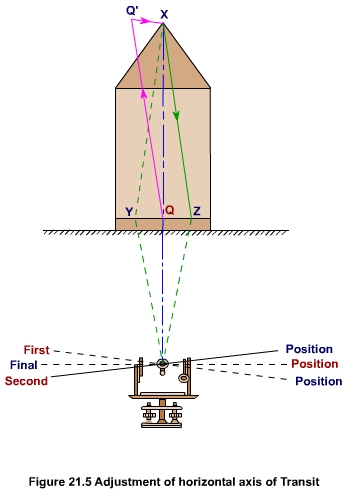The horizontal axis is required to be perpendicular to the vertical axis.
Test : In order to test it, first the instrument (in face left condition) is temporarily adjusted in front of high building or structure on which a well-defined point, say X, can be marked at considerable height. Then opening the vertical clamp, sight at the point X in such a way that the point appears on the vertical cross hair of the telescope. Now, with the horizontal motions clamped, depress the telescope and set a point Y on or near the ground. If the horizontal axis is perpendicular to the vertical axis, X and Y will be in the same vertical plane. Then, bisect the point X again in the face right condition. On depression of the telescope as before, if the line of sight falls on Y, the horizontal axis is perpendicular to the vertical axis (Figure 21.5a).
Adjustment : On depression of the telescope (on face right condition), if the line of sight does not falls on Y, but at some other point say Z (Figure 21.5), the instrument requires adjustment. Now, select another point say Q, halfway between Y and Z and at the same level should be marked. The telescope is then focused the point in such a way using upper plate tangent screw that Q appears on the vertical cross hair and then, elevate the telescope until the line of sight is beside X; loosen the screws of the bearing cap, and raise or lower the adjustable end of the trunnion axis until the line of sight is intersects X.
When the trunnion axis has been adjusted, the line of sight intersects both X and Q as the telescope is rotated about the vertical plane about the horizontal axis.
Raising or lowering the trunnion axis may cause movement of the vertical crosshair away from the point Q. So. After each movement of the adjusting screw, the point Q on the staff should be checked. If necessary, it should be adjusted using one of the horizontal tangent screws. (Figure 21.5).
